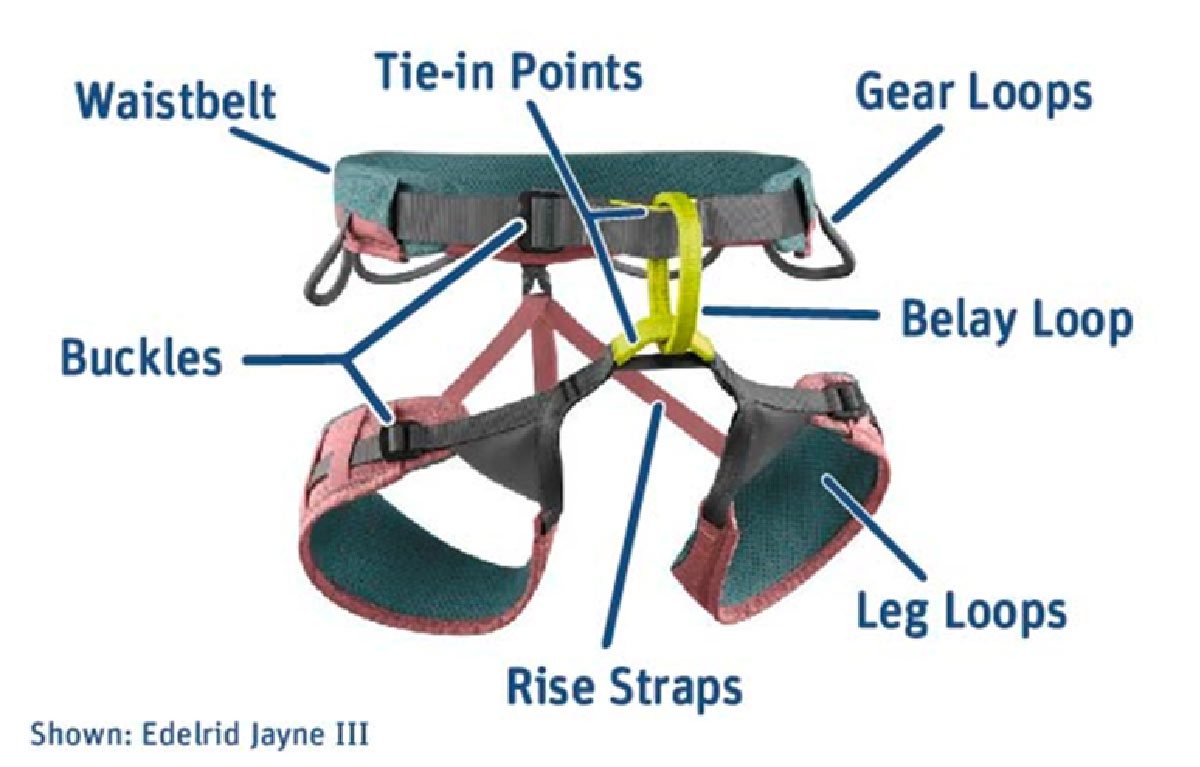

The Ultimate Guide to Choosing the Right Rock Climbing Harness
Any type of roped climbing requires the climber and belayer to both have a climbing harness. This guide will walk you through everything you need to know to select the perfect harness for your needs, whether you are just starting or looking to replace an existing one.
If you’re a beginner, we’ll first break down the key components of a harness and the safety standards for you, and then we’ll run through the types of climbing harnesses available.
By the end of this guide, you'll know how to choose a harness that not only fits well but matches your climbing style..
In case you have urgency, here is what you will read in this article.
Table of Contents:
1- Anatomy of Climbing Harnesses

Waistbelt: Provides support around the waist and includes a buckle for adjustment.
Leg Loops: Two loops that fit around the thighs, often with buckles for adjustment.
Gear Loops: Loops at the sides for clipping quickdraws, cams, and other gear.
Rise Straps/Leg Loop Attachments: Straps that stabilise the leg loops and waistbelt.
Belay Loop: A separate reinforced loop between the waistbelt and leg loops, primarily used for attaching belay devices, carabiners, or other hardware. In general, it is not recommended to tie the rope through the belay loop for tying in. Instead, the belay loop is more commonly used for belaying or rappelling. Often distinct in color and highly durable.
Tie-in Points: Two reinforced loops (one at the waist and one at the leg loops) designed for tying in with the rope.
2- Harness Safety Standards
Before a rock climbing harness hits the shelf, it has likely gone through testing to make sure it can hold up when you blow a big move.
There are only two globally recognised standards for climbing harnesses: the UIAA (International Federation of Mountaineering Associations) and the European standard, EN 12277. In Australia, Type C sit harnesses are not certified to any standard by law, although, any major brand selling quality harnesses has likely tested them to be sold internationally.
To check if it has, look for the UIAA and CE indicators, usually found on the packaging or tags, to have peace of mind that your harness is manufactured correctly. This would be especially important if you're unsure about the quality of an off-brand harness and want to avoid serious risk.

3- Types of Climbing Harnesses
Apart from a few exceptions, any Type C sit harnesses will work for most people and scenarios in rock climbing. It is recommended that smaller children and very heavy adults should wear a chest harness in conjunction with a sit harness.
Gym/Indoor Climbing Harnesses
Gym harnesses work well for beginners – they are simple and lightweight, with few or no gear loops, as climbers typically only need to attach a chalk bag or a single quickdraw for lead climbing. They often have non-adjustable leg loops, as climbers generally wear similar clothing indoors, and a thinner belay loop to reduce weight. Easy to put on, easy to use, and perfect for those just learning the basics.

Edelrid Jay III and Jayne III are great options for the gym.
Sport Climbing Harnesses
Sport climbing harnesses are built to handle frequent falls and extended belaying, which is common in sport climbing when projecting difficult routes. These types of harnesses perform best at crags like Kangaroo Point Cliffs.
These harnesses offer a range of padding options in the waistbelt and leg loops. Despite the need for padding to protect against frequent falls, a sport climbing harness should be lightweight enough to support dynamic movements and technical climbs. As a result, you can hardly feel it during a session.

A sports harness with a solid balance of padding and reduced weight is the Edelrid Ace.
Sport climbing harnesses typically only have two gear loops, which are sufficient for carrying up to 20 quickdraws and carabiners—all the gear needed for a sport route. Pay attention to the rigidity of the gear loops as rigid ones make clipping in quicker and more reliable.


For high-level competition or ambitious sport climbers, a minimalist, buckle-free harness like the Edelrid Prisma offers the ultimate combination of reduced weight and maximum freedom of movement.
Traditional and Multi-Pitch Climbing Harnesses
The main differences with a trad/multi-pitch climbing harness are a step up in gear loops and padding in the waistbelt and leg loops. This is because trad and multi-pitch climbs involve carrying a lot more gear and hanging belays are much more common.
When picking a climbing harness for trad, pay attention to the design of the gear loops and match the amount you need to the amount of gear you plan to carry. Many also come with a haul loop for carrying a second rope or additional gear.
At crags like Frog Buttress—which has many trad routes—having a harness with plenty of gear loops is essential. Another great local spot for long, technical multi-pitches is the Glasshouse Mountains, where comfort and gear management are crucial.

A harness with a floating waistbelt, like the DMM Renegade, allows the waistbelt to stay in place even when you’re shifting or twisting, keeping the padding securely on your hips throughout the climb.
Alpine Climbing Harnesses
Alpine harnesses prioritise being lightweight and easy to pack for moving quickly on long varied climbs, while having enough function for the climbing and the conditions you expect to face.
That’s why choosing the right alpine harness requires careful consideration. In general, while some padding for comfort is included in an alpine harness, it’s kept minimal to prioritise speed and reduce bulk–often using advanced construction techniques such as frame or laminated construction to reduce weight.
These harnesses typically feature fewer gear loops to maximize efficiency, though models designed for ice or mixed climbing often come with extra gear loops and ice clipper slots for carrying tools like ice axes, crampons, or ice screws.
For alpine-style climbs, destinations like New Zealand’s Southern Alps or Tasmania’s Cradle Mountain offer the kind of challenging conditions that demand gear that is light, functional, and adaptable. Adjustable waist and leg loops are crucial for managing layering during these climbs, ensuring a snug fit regardless of the conditions.

Arcteryx AR385a delivers elite performance across the climbing’s entire spectrum including alpine climbing.

Edelrid Sirana TC - a bluesign-certified alpine climbing harness signed by Tommy Caldwell.
Big Wall Climbing Harnesses
For big wall climbing, the top priority of your harness is almost always how comfortable it feels around your waist and legs. Big wall climbing harnesses come with extra thick padding, particularly in the lumbar area, as spending multiple hours, or sometimes days, you’ll find can make your back really sore.
These harnesses also need to be feature-packed for a big wall route. You'll want several large, reinforced gear loops to carry all your essential gear. You also want to look for detachable leg loops for greater convenience when managing bathroom breaks, changing clothes, or adjusting layers. With all this padding you are likely sacrificing weight, so the style of your big wall climb—whether it’s a speed ascent or a lengthy expedition—will help determine the right balance between comfort and efficiency.

The Rock Empire Gladiator is a good example for Big Wall climbing harness, it offers maximum padding, wide waist and legs and extra reinforcement in the lumbar region of the back.
The most important thing when choosing your next harness is finding one that fits your climbing style and goals. Beyond that, regularly inspect your harness, take good care of it, and don’t hesitate to swap it out when the time comes to stay safe.
If you need further assistance or personalised advice on picking the perfect climbing harness, feel free to visit K2 Base Camp in-store or ask us online! Our expert staff can help you find exactly what you need from our extensive selection to suit all climbing styles and levels. Happy climbing!
Climbing Harness Frequently Asked Questions
Just like any other safety climbing gear, it’s important to check your harness regularly to make sure it’s still safe. Most harnesses last between one and five years, but there are other factors to consider when deciding if it is time to replace one, and they aren’t always about visible wear.
Even if your harness has been stored carefully and appears undamaged, factors like how often you use it, the conditions it's exposed to, and how well it's maintained all impact its lifespan. While the typical lifespan is one to five years, manufacturers usually avoid giving exact timelines, as this could create a false sense of security.
Any signs of significant wear, such as frayed edges, slits, worn-out areas, or faded materials—especially on critical parts like the tie-in points, buckles, belay loops, or waistbelt—mean the harness should be retired immediately.
UV radiation can fade colors and age the harness faster, making the materials brittle and less elastic, which can compromise safety even if the harness appears functional. Similarly, storing it in cold or damp conditions can weaken its load-bearing capacity without obvious signs of damage.
Frequency of use is another key factor. If you’re climbing two to three times per week, consider replacing the harness after 1-2 years. For occasional climbers using it about once a month, aim to replace it around the 3-4 year mark.
Properly fitting a climbing harness is crucial for safety and comfort, but can also enhance your climbing performance. To fit a harness, follow these steps:
1. Loosen the straps and step into the harness, ensuring the waistbelt sits above your hips for safety.
2. Tighten the waistbelt so it's snug but not constricting. You also want to have the padding close together or overlapping at certain areas for maximum comfort as exposed straps can dig in.
3. Adjust the leg loops one at a time to be secure but comfortable, allowing for a range of movement without pinching. The degree to which the leg loops are tightened will improve the comfort while dead-hanging, but at the expense of your range of movement and mobility, so it is important for you to find the right balance each time you climb.
4. Check that the harness sits evenly on your body and double-check all buckles are properly secured.
5. Test your harness before you start climbing to make sure you have it in the right position.
You should keep your harness as clean as possible because dirt can make it stiff and brittle, and sand and grit can wear down the material over time.
To clean it, use a soft brush to get rid of any dirt from the webbing and hardware, and gently wash it with mild soap and lukewarm water (never hotter than 40°C). We recommend any non-halogenated laundry detergent free from harsh chemicals. One that is widely available is Earth Choice Laundry Liquid which is a great option for cleaning sensitive textile materials.
It’s best to slowly air dry a harness inside or in a shaded area to avoid direct sunlight and high heat sources that can weaken the fibers. Never throw it in the washing machine or tumble dryer.
